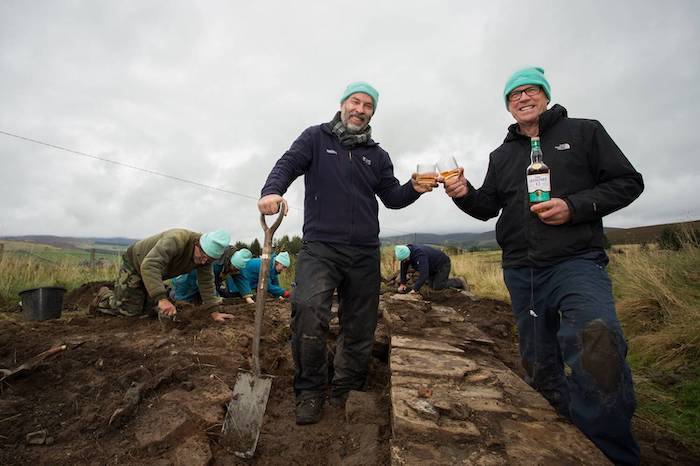Archaeologists recently announced they have uncovered secrets of Scotland’s whisky history in an excavation at the old site of The Glenlivet Distillery, described as one of Scotland’s first whisky distilleries to be licensed after the 1823 Excise Act.
The dig at the site of Upper Drumin in Speyside, which is a kilometer upslope from the modern distillery, has so far uncovered the floor of the old site, which dates from 1824.
This is where The Glenlivet’s founder, George Smith, is said to have risked life and liberty to produce his single malt whisky. Fragments of bottle glass and ceramics believed to have been involved in whisky production were also found.

Work took place the week of October 4-9, and the investigations were carried out as part of the Pioneering Spirit project, a partnership between the National Trust for Scotland and The Glenlivet, to uncover and share the history and impact that whisky production has had on Scotland’s cultural heritage and way of life.
The old distillery site was first a farm, converted to a whisky production site by Smith in response to the 1823 Excise Act. That act made licensed production of whisky possible.
Before that date, Smith, like many others in communities across Scotland – including Speyside and the Highlands – had produced the spirit illegally, smuggling the spirit to their customers. Smith was the first illicit producer to get his license.
Apart from the remains of two of the old mill dams, nothing of the former distillery survives above ground. The site, which is on Crown Estate Scotland land, is marked by an inscribed monument, indicating its important role in whisky history.
Derek Alexander, the National Trust for Scotland’s head of archaeology, has a long association with the location and conducted a survey of the distillery remains in the 1990s.
“Returning here after nearly 25 years to finally uncover the remains of this special place is really inspiring,” Alexander said in a prepared statement. “What’s really interesting is that this is where the illicit production of whisky, which is what we find evidence of at our National Trust for Scotland sites, and the transition towards larger-scale industrial production meet. This site is a formative part of the whisky industry becoming one of Scotland’s biggest and most successful. It’s such a powerful part of our national story and identity, which is loved and recognised at home and around the globe.”
Alexander said that brushing dirt from the flagstones where Smith, one of the leading figures of Scotland’s whisky industry, stood was “simply incredible.”
Alan Winchester, The Glenlivet’s Master Distiller, said that he’s always been fascinated by The Glenlivet’s rich history, and it’s been a delight to enter the second year of a partnership with the National Trust for Scotland.
“The majority of my career has been spent continuing the legacy of our founder George Smith, so it’s really interesting to have the opportunity to uncover even more secrets about our illicit past and tell new stories about the role scotch has played in defining Scottish culture,” he added.
Volunteers, including staff from The Glenlivet and members of the local community, took part in the dig, with the support of the Crown Estate Scotland Ranger Service.







